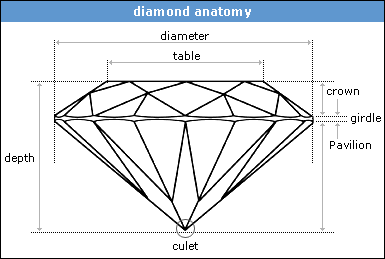We’ve already covered Step #1 (the four C’s: color, cut, clarity & carat), and Step #2: how to determine if your diamond is real or fake. Step #3 is knowing the anatomy of the diamond. When our gold buyers buy diamonds at our gold parties (both here in California and all over the U.S.) they all follow these basic steps that I’m sharing with you. When you learn these basics, you will be in a better position to buy diamonds from your local jeweler, or to determine the quality of the diamonds you currently own…and let us here at GlitterBug Gold Parties give you a quote!
Diamond Anatomy
Table
- This is the first surface (surfaces in gems are called facets) that you will see. It is on top of the diamond, and is the largest area in the whole stone’s body.
Crown
- This is the upper part of the diamond just above the girdle that includes the table and the bezel facets around. (The girdle is the outer edge of the diamond forming the stone’s total width around it.)
- The crown slopes down to the girdle and this is called the crown angle. It passes and intersects the stone’s bezel facets. (The bezel is the metal holding the stone around the girdle.)
- This crown angle helps in the dispersion of light, called fire, in a diamond. It also helps to enhance the diamond’s brilliance.
Girdle
- This is the narrow band encircling the widest part of the diamond. This part of the stone is sometimes faceted (tiny polished surfaces) and some are not. Some jewelers have the diamond’s certificate number inscribed in laser on the girdle.
Pavilion
- This is the bottom part of the diamond, essentially the facets just below the girdle, all leading to the culet. This is where lights come in and is reflected out of the stone’s table.
Culet
- This is the pointed end at the bottom of the stone which may be faceted (a tiny polished surface at the endpoint) to protect from chipping.
- In the early days, large faceted culets were common in diamonds, especially the Old European or Old Mine cuts. Modern diamonds have very small culets or none at all.
The above are only the basic physical parts of the diamond, but there are other considerations that will determine the value of the gem.
Depth
- This is the stone’s measurement from the culet to the table. The stone’s depth is responsible for the correct angling and height for light to enter and be reflected back to the viewer in a fascinating array of light.
- These flashes of reflected light are commonly referred to as sparkle. The intensity of this reflected bunch of light beams to the top of the diamond is called brilliance. When a diamond moves, there are flashes of color reflected from within, and it is called fire.
Symmetry
- This is another important gauge in a diamond’s desirability because this is an indicator of the stone’s quality. Misalignments (facet angles, polish, lengths, etc) can diminish some of the diamond jewelry’s other near-perfect qualities.

